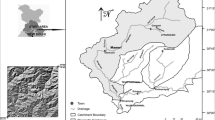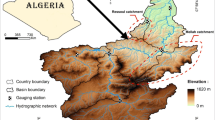Abstract
The suspended sediment load in rivers is an important parameter in watershed planning and management. Since daily suspended sediment time series contain linear and nonlinear components, existing prediction models are associated with limitations. Therefore, this study introduces a new hybrid model comprising two commonly used stochastic and nonlinear models. The sediment load is first modeled by an autoregressive-moving average with exogenous terms (ARMAX) model. Subsequently, the ARMAX residuals are modeled with an artificial neural network (ANN). For this purpose, discharge (Q) and sediment (S) are considered as model input parameters. Three modeling scenarios are defined to investigate the impact of data normalization on the hybrid model. The exponential and Box-Cox transformation methods are combined into a new data normalization method called mixed transformation. The performance of these methods is then compared. In addition, the impact of the type and number of input combinations on ARMAX-ANN model accuracy is evaluated. To this end, 12 input combinations and 1331 ARMAX and ANN models are verified. The ARMAX model inputs include S, Q and the white noise disturbance term (e), while the ANN model inputs include the ARMAX model results and residuals. Moreover, the hybrid model’s accuracy is compared with the ARMAX and ANN models.






Similar content being viewed by others
References
Afan HA, El-Shafie A, Yaseen ZM, Hameed MM, Mohtar WHMW, Hussain A (2015) ANN based sediment prediction model utilizing different input scenarios. Water Resour Manag 29:1231–1245
Alizdeh MJ, Joneyd PM, Motahhari M, Ejlali F, Kiani H (2015) A Wavelet-ANFIS model to estimate sedimentation in dam reservoir. Int J Comput Appl T 114:19–25
Alp M, Cigizoglu HK (2007) Suspended sediment load simulation by two artificial neural network methods using hydrometeorological data. Environ Model Softw 22:2–13
Cigizoglu HK, Kisi O (2006) Methods to improve the neural network performance in suspended sediment estimation. J Hydrol 317:221–238
Demirci M, Üneş F, Saydemir S (2015) Suspended sediment estimation using an artificial intelligence approach. In: Heininger P, Cullmann J (eds) Sediment Matters. Springer International Publishing, Switzerland, pp 83–95
Faruk DÖ (2010) A hybrid neural network and ARIMA model for water quality time series prediction. Eng Appl Artif Intell 23:586–594
Kisi O, Dailr AH, Cimen M, Shiri J (2012) Suspended sediment modeling using genetic programming and soft computing techniques. J Hydrol 450:48–58
Kumar D, Pandey A, Sharma N, Flügel WA (2016) Daily suspended sediment simulation using machine learning approach. Catena 138:77–90
Lafdani EK, Nia AM, Ahmadi A (2013) Daily suspended sediment load prediction using artificial neural networks and support vector machines. J Hydrol 478:50–62
Liu H, Tian HQ, Li YF (2012) Comparison of two new ARIMA-ANN and ARIMA-Kalman hybrid methods for wind speed prediction. Appl Energ 98:415–424
Marco JB, Harboe R, Salas JD (2012) Stochastic hydrology and its use in water resources systems simulation and optimization. Springer Science & Business Media, Peniscola
Moeeni H, Bonakdari H (2016) Forecasting monthly inflow with extreme seasonal variation using the hybrid SARIMA-ANN model. Stoc Environ Res Risk Assess. https://doi.org/10.1007/s00477-016-1273-z
Moeeni H, Bonakdari H, Ebtehaj I (2017) Integrated SARIMA with neuro-fuzzy systems and neural networks for monthly inflow prediction. Water Resour Manag 31:2141–2156
Mustafa M, Rezaur R, Saiedi S, Isa M (2012) River suspended sediment prediction using various multilayer perceptron neural network training algorithms - a case study in Malaysia. Water Resour Manag 26:1879–1897
Nourani V, Kisi Ö, Komasi M (2011) Two hybrid artificial intelligence approaches for modeling rainfall–runoff process. J Hydrol 402:41–59
Rahim A, Akif A (2015) Optimal artificial neural network modeling of sedimentation yield and runoff in high flow season of Indus River at Besham Qila for Terbela dam. Int J Sci Res 4:479–483
Salas J, Delleur J, Yevjevich V, Lane W (1988) Applied modeling of hydrologic time series. Water Resources Publications, Colorado
Tiwari H, Rai SP (2015) Discharge and sediment time series, uncertainty analysis using the maximum likelihood estimator and artificial neural network. J Water Res Environ Eng 1:1–9
Zhang GP (2003) Time series forecasting using a hybrid ARIMA and neural network model. Neurocomputing 50:159–175
Author information
Authors and Affiliations
Corresponding author
Rights and permissions
About this article
Cite this article
Moeeni, H., Bonakdari, H. Impact of Normalization and Input on ARMAX-ANN Model Performance in Suspended Sediment Load Prediction. Water Resour Manage 32, 845–863 (2018). https://doi.org/10.1007/s11269-017-1842-z
Received:
Accepted:
Published:
Issue Date:
DOI: https://doi.org/10.1007/s11269-017-1842-z




